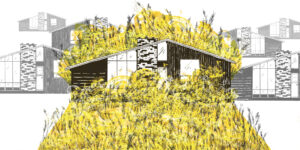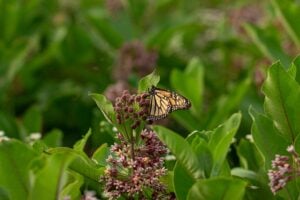
Environment
Our shared garden: The importance of native plants
As cities and towns continue to expand into our wild landscapes, conservation gardens can provide refuge for Canada’s plummeting biodiversity
- 3462 words
- 14 minutes
Environment
The student-led Ravine Stewardship Team at Toronto French School is providing local acorns to neighbours and nurseries to increase the city’s native tree canopy

Janaya*, a Grade 12 student at Toronto French School, unlocks a gate in the tall chain link fence behind the sports field, and steps into another world. Dead leaves rustle underfoot as Janaya and a dozen of her fellow students thread their way carefully down a path into a steep ravine that borders the school campus. Stately trees rise around them — red oak, black cherry, sugar maple, hemlock, white pine. The school owns about 12 hectares of Toronto’s famed ravine network; its pupils grow up in this forest. Janaya and her classmates played tag here in grade school, and now, in high school biology class, they’re researching forest health.
This forest on the bank of the Don River looks solid and serene – a verdant contrast to the city that hums on all sides. But after mapping the ravine and analyzing its trees and plants, the students posit that these woods, like many forested areas in Toronto, are in trouble. Invasive species threaten to take over. With the help of their biology teacher, Dr. Tamara Smith, the students, who call themselves the Ravine Stewardship Team, believe they can do something to help.
Today, the students lug grocery bags full of red oak acorns through the woods. Oak trees produce acorns on a cycle every few years, and 2023 has been a banner year. These acorns were collected from oaks on school grounds, at a neighbouring high school, a university, and a private club that borders the ravine.
“It was like, a lot,” says Janaya. “We had a whole wagon.”
With their acorn haul, the students are playing a small but important role in sustainable local reforestation. Forests Ontario, a non-profit based in Barrie, Ont., has a contract to supply source-identified trees and shrubs to the City of Toronto. As part of this effort, the organization signed an agreement to buy 15 litres of acorns from the students. “The seedlings we provide to the City of Toronto must be 100 per cent native species, with 50 per cent from local sources,” says Mark McDermid, seed and stock specialist at Forests Ontario. “It’s nice to have local sources from trees that have been there for hundreds of years.”
A nursery near Hamilton has already planted some seeds gathered by the students, to grow into oak seedlings. The city will then plant these oak trees in ravines and open spaces to increase its native tree canopy.

Toronto French School has found another way to play a part in shoring up native biodiversity in the city. The school has sent thousands more acorns to a second nursery. The school plans to plant these oak seedlings and offer them to its neighbours as part of an effort to enhance local genetic diversity. The Ravine Stewardship Team organized a community dinner to promote the plan; one club member designed a sustainable menu for the event that featured veggie burgers made with chickpea and sweet potato patties. About 100 community members attended.
But the students know that not every acorn they picked up will grow into an oak tree. On their lunch hour in the quiet ravine, the students kneel on a tarp and pour their remaining acorns into a bucket of water. Acorns that float are pulled out and set aside.
“The ones that are lighter would not have as many nutrients,” explains Caitlin, a Grade 12 student. These “floaters” are passed on to younger students for arts and crafts projects. The acorns that sink are viable for reproduction; the school plans to plant these acorns in plots on school grounds.

But why all this effort to gather and plant local seeds? The students pause from sorting acorns to explain the plight of Toronto’s ravines. The ravines’ biggest challenge is the Norway maple. For decades, city forestry departments across North America planted Norway maples along streets, because the hardy species tolerates concrete, soil compaction, pollution, salt and other indignities of urban life. Too late, cities realized that the Norway maple is an aggressive invader. The tree takes over forests, spreading thick leaves that open first and fall last. In the Norway’s sprawling shade, native species such as oaks, pines and sugar maples cannot establish or grow. Native insects, birds and mammals do not thrive in Norway maple forests, which become green deserts. In a 2018 paper, researchers at the University of Delaware explained that non-native plants “lack an evolutionary history with native fauna and support insect communities that are less abundant and diverse,” which changes food availability for other forest inhabitants.
Currently, the City of Toronto is removing Norway maples from its ravines and replacing them with native tree species. And thanks to Toronto French School students, some of the planted trees will be very local stock – perfectly in harmony with their environment.
Says Janaya, “We see a lot of news and it’s all very depressing. We have so many environmental problems and not a lot of people doing anything, so it’s encouraging when you see how many people we can inspire with the resources we have. If you are passionate, it really shows.”
Adds McDermid of Forests Ontario, “Getting youth involved in this kind of work is critical. Down the road they can say, ‘I was part of that tree.’ That’s a pretty awesome thing for a young person to see.”
*Last names of students have been omitted at the school’s request to protect their privacy.
Get involved
Help grow the Network of Nature
Network of Nature is a tool that helps you to identify native plants that are appropriate for restoration, gardening, and other planting needs across Canada.

Environment
As cities and towns continue to expand into our wild landscapes, conservation gardens can provide refuge for Canada’s plummeting biodiversity

Environment
As cities and towns continue to expand into our wild landscapes, conservation gardens can provide refuge for Canada’s plummeting biodiversity

Environment
The planet is in the midst of drastic biodiversity loss that some experts think may be the next great species die-off. How did we get here and what can be done about it?

Kids
The Canadian Geographic Challenge, now in its 20th anniversary year, will bring 20 young…

People & Culture
Depending on whom you ask, the North’s sentinel species is either on the edge of extinction or an environmental success story. An in-depth look at the complicated, contradictory and controversial science behind the sound bites

People & Culture
As the climate heats up, so do talks over land ownership in the Arctic. What does Canadian Arctic Sovereignty look like as the ice melts?